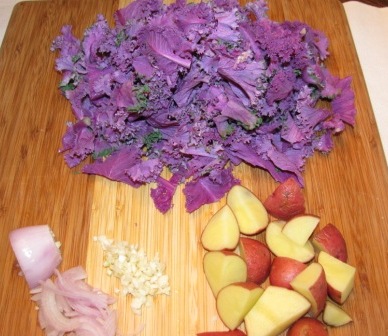A traditional "pithivier" (pronounced pee-tee-VYAY) is a round puff pastry dessert, with scalloped edges that typically contains a sweet almond frangipane or fruit filling and is served with coffee. The dessert is believed to have originated from Pithiviers, France, however I was unable to conclusively determine the veracity of this claim.
Though primarily made as dessert or coffee cake, a pithivier is also often filled with a savory filling, as is the case here. The hallmarks of a traditional pithivier is its puff pastry crust, scalloped edges carved around the pie, a shiny top crust achieved via a generous egg glaze and a decorative design of curved lines radiating from the center carved on the top crust.
I made the pie to the recipe's specifications but added some chopped spinach and parsley to give it a bit more color and substance. I personally think this savory pie is better suited as an entree instead of an appetizer, because once you cut the pie into small wedges you lose its decorative features. The pie is quite delicious, not too rich or dry, and a great use of those Easter leftovers.
Ham Pithiviers
1 store bought package of puff pastry, well thawed
3/4 c. finely chopped cooked ham
1 T. mayonnaise
1/4 tsp. Worcestershire sauce
1/8 tsp. black pepper
1/4 c. grated Parmesan cheese (3/4 oz.)
2 T. thinly sliced green onions
1 hard cooked egg, chopped
1 T. chopped parsley
1/4 c. chopped raw baby spinach
Egg glaze: 1 egg plus 1/4 tsp. salt
Prepare filling and set aside:
In a medium bowl combine the ham, mayonnaise, Worcestershire sauce, black pepper.
Add the Parmesan cheese, green onions, parsley, and spinach. Mix well and then add the egg making sure not to smash the eggs. Set aside.
Prepare puff pastry:
Unfold puff pastry sheets (2). Make sure they are fully thawed and somewhat soft and pliable.
On a lightly floured surface or sheet of parchment paper, roll out 1 portion to a 9-inch square. Using a 8-inch round pan or dish, cut an 8-inch circle from the center of the square. Place the circle (with the parchment paper) on an ungreased baking sheet.
Prepare egg glaze by lightly beating the egg with the salt. Lightly brush glaze around edge of circle, making a 1 1/2-inch border and being careful not to let the glaze drip over the edge.
Place ham mixture in center of circle and spread to inside edge of glazed border. Mound mixture slightly in center. Roll out remaining dough to a 9-inch square. Cut another 8-inch circle. Place on top of ham-topped circle, stretching as necessary to match edges and deflating any air pockets. Press edges firmly with your fingers to seal. Use the point of a knife to cut a small hole in center of top pastry. Brush top with egg glaze, being careful not to drip over edge. With a small sharp knife, make a design on the pastry using 1/16-inch deep cuts. Do not cut all the way through dough. Long curved lines radiating from the center are traditional, but any pattern may be used. Now scallop the edges with the back of the knife at 1/4-inch intervals.
Refrigerate 30 minutes or longer. Preheat oven to 450F degrees. Bake 15 minutes. Reduce heat to 400F degrees and bake another 20 to 30 minutes (watch closely) until pastry is puffed and golden brown. Cool slightly and serve warm. Makes 8-10 appetizer servings or 4-5 generous lunch/entree servings.
































